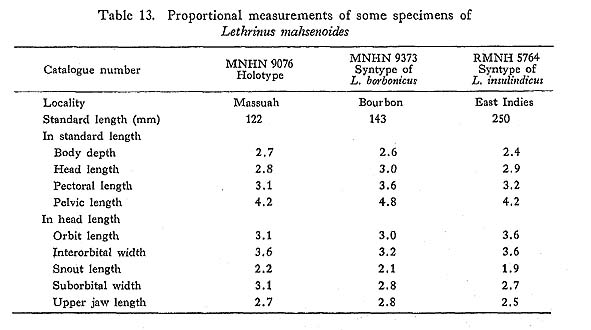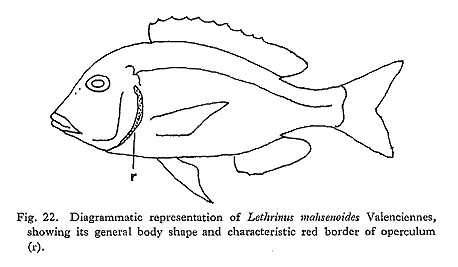V. DESCRIPTIONS
13. Lethrinus mahsenoides Valenciennes
13. Lethrinus mahsenoides Valenciennes |
 Plate 2 |
Lethrinus mahsenoides Valenciennes in Cuvier & Valenciennes, 1830; 286, Red Sea;Klunzinger, 1870: 755, Red Sea; 1884: 39, pl. 6, figs. 2, 2a, Red Sea; Bleeker, 1850: 15, Batavia;
Lethrinus borbonicus Valenciennes in Cuvier & Valenciennes, 1830: 303, Bourbon; Smith, 1959: 290, pl. 20, fig. F, pl. 24, fig. 9373, pl. 25, fig. 9076, East Africa, type, type of L. mahsenoides.
Lethrinus insulindicus Bleeker, 1873a: 334, Batavia (Java), Makassar (Celebes),Amboina, Atapopo (Timor), Philippines; 1873-76: 117, pl. 316, type.
Specimens examined.
Holotype. —MNHN9076 (122mm standard length) from Massuah, Red Sea.
Syntypes of L. borbonicus. —MNHN9373 (2 individuals: 143, 139), MNHN9092
(143) from Bourbon.
Syntypes of L. insulindicus. —RMNH5764 (5: 129, 182, 193, 220, 250) from East Indies.
SMF5299 (197), 5640 (1 of 5: 186), MNHN9083 (2: 188, 184), 9590 (1 of 2: 145), 9390 (1 of 2: 149), 9371 (160), 9067 (184) from Red Sea.
MNHN9083 (2: 184, 188) from Zanzibar.
SMF5284 (183) from Indian Ocean.
UMUTZ52892 (223), 52891 (267) from Singapore.
UMUTZ52848 (202), ABE16411 (207), 16416 (215) from Phuket.
D. X, 9; A. III, 8; P1. 13; P2. I, 5; C. 8 + 7; L. lat. 46 to 48; Ltr. 6 or 7/i/15 to 17.
Proportional measurements of some specimens are shown in Table 13.

Head length less than body depth. End of jaws between the verticals through posterior
nostril and through anterior end of orbit. Interorbital area flat or a slightly convex. Third to fifth dorsal spines longest. 6 scale rows between lateral line and median dorsal spines. Inner base of pectoral densely covered with scales. Lateral teeth of jaws include strong molars in adults.
Color. —Head yellowish-brown, body greenish-gray. Posterior border of operculum bright red. Individual scales on body with yellow center. Fins red. Pectoral and pelvic paler.
Distribution. —Red Sea, East Africa to East Indies.
Remarks. —The present species seems to be closely related with L. ornatus. No character has been found which is useful enough to distinguish these two species except for color patterns. Their relationship is left as an open problem.
